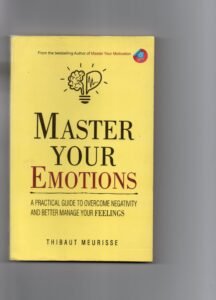Your cart is currently empty!
Here’s a chapter-wise summary of Master Your Emotions by Thibaut Meurisse, condensed to approximately 1500 words by improvewithshyam.com/in/online.

| Shyam Gopal Sharma | ||
 |
|
Chapter 1: What Are Emotions?
This chapter defines emotions as biochemical reactions that result from the interaction of thoughts and external stimuli.
Key Points:
- Emotions are temporary and subjective.
- They influence our behavior and perception of reality.
Writer explains how emotions are coming aware of thereated and tied to our evolutionary need for survival, emphasizing the importance of becom to avoid impulsive decisions.
Chapter 2: Why We Feel the Way We Do
Here, Writer explores the root causes of emotions, such as personal beliefs, life experiences and thought patterns.
Key Points:
- Beliefs shape emotions; limiting beliefs amplify negativity.
- External events don’t directly cause emotions—it’s our interpretation of these events that matters.
The author highlights the “cycle of emotions” and how unchecked thoughts reinforce negative emotional loops.
Chapter 3: The Three Main Causes of Negative Emotions
Meurisse identifies three key drivers of negative emotions: unmet expectations, unresolved past experiences, and a lack of gratitude.
Key Points:
- Expectations create emotional tension when unmet.
- Past trauma or unresolved feelings affect current emotional states.
- Gratitude disrupts negativity by shifting focus to the positive aspects of life.
Practical Tip: Reflect on your expectations and consider their realism.
Chapter 4: Breaking Free from Negative Emotions
The author outlines strategies to detach from negative emotions and reframe them.
Key Points:
- Observe emotions without judgment.
- Use reframing to challenge limiting beliefs.
- Accept discomfort rather than suppressing it.
Meurisse introduces mindfulness as a powerful tool to break the automatic reaction cycle.
Chapter 5: How to Cultivate Positive Emotions
This chapter emphasizes building positive emotional habits to enhance well-being.
Key Points:
- Practice gratitude daily.
- Engage in activities that bring joy and fulfillment.
- Create empowering rituals, such as meditation or journaling.
Practical Tip: Focus on small wins and celebrate them to reinforce positivity.
Chapter 6: How to Build Emotional Resilience
Emotional resilience helps you bounce back from challenges. Meurisse explains how to strengthen this trait.
Key Points:
- Accept that setbacks are a natural part of life.
- Shift from a victim mindset to a growth mindset.
- Build a support system of people who encourage you.
Practical Tip: Use self-talk to reframe failures as learning opportunities.
Chapter 7: The Role of the Subconscious Mind
The author delves into how subconscious programming affects emotions and behavior.
Key Points:
- The subconscious mind operates based on past conditioning.
- Reprogramming it requires conscious effort and repetition.
- Positive affirmations and visualization help align the subconscious with desired emotional states.
Meurisse encourages readers to examine their self-image and replace disempowering beliefs.
Chapter 8: Emotions and Decision-Making
This chapter explores how emotions influence decision-making and the importance of self-awareness in making better choices.
Key Points:
- Emotional decisions are often impulsive and short-sighted.
- Pausing and reflecting before acting leads to better outcomes.
Practical Tip: Practice emotional detachment by recognizing the difference between feelings and facts.
Chapter 9: The Impact of Your Environment
Meurisse highlights the role of the external environment in shaping emotions.
Key Points:
- Surround yourself with positive influences.
- Declutter your physical and mental space.
- Consume uplifting content rather than negativity.
Practical Tip: Audit your environment and remove triggers that fuel negative emotions.
Chapter 10: The Power of Gratitude
Gratitude is described as one of the most effective tools for mastering emotions.
Key Points:
- Gratitude rewires the brain to focus on abundance.
- Practicing gratitude shifts attention away from scarcity and problems.
Practical Tip: Write three things you’re grateful for each day.
Chapter 11: The Role of Habits
Habits determine long-term emotional states. Meurisse stresses the importance of building constructive emotional habits.
Key Points:
- Small daily habits compound over time.
- Replace destructive habits with positive ones.
- Practice emotional habits consistently, such as mindfulness or deep breathing.
Practical Tip: Start with one habit at a time to avoid overwhelm.
Chapter 12: Aligning Your Life with Your Core Values
Living in alignment with core values creates emotional harmony.
Key Points:
- Identify your core values and assess whether your life aligns with them.
- Incongruence between actions and values leads to inner conflict.
Practical Tip: Create a vision that reflects your values and work toward it.
Chapter 13: Embracing Uncertainty
Meurisse advises embracing uncertainty as an inevitable part of life.
Key Points:
- Fear of the unknown triggers anxiety and negative emotions.
- Accepting uncertainty opens the door to growth and opportunity.
Practical Tip: Focus on what you can control rather than worrying about the future.
Chapter 14: The Role of Purpose in Emotional Well-Being
Having a sense of purpose enhances emotional resilience and positivity.
Key Points:
- Purpose gives meaning to challenges and setbacks.
- Align daily actions with long-term goals for a sense of fulfillment.
Practical Tip: Reflect on what brings you joy and how you can contribute to others.
Conclusion
The book concludes with a reminder that mastering emotions is a lifelong journey. Meurisse encourages readers to practice the tools and strategies consistently to experience meaningful change.
by
Tags:
Leave a Reply